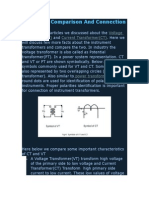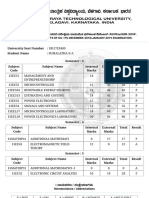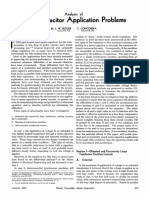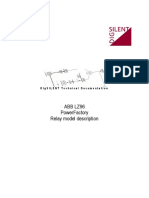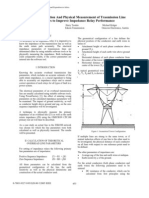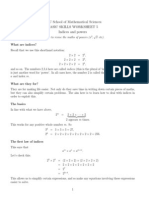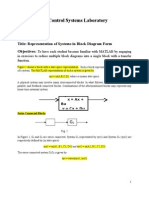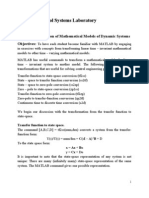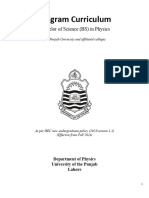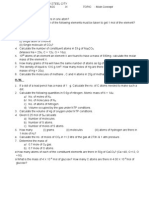Measurement of Line Impedances and Mutual Coupling of Parallel Lines
Measurement of Line Impedances and Mutual Coupling of Parallel Lines
Uploaded by
Khandai SeenananCopyright:
Available Formats
Measurement of Line Impedances and Mutual Coupling of Parallel Lines
Measurement of Line Impedances and Mutual Coupling of Parallel Lines
Uploaded by
Khandai SeenananOriginal Description:
Original Title
Copyright
Available Formats
Share this document
Did you find this document useful?
Is this content inappropriate?
Copyright:
Available Formats
Measurement of Line Impedances and Mutual Coupling of Parallel Lines
Measurement of Line Impedances and Mutual Coupling of Parallel Lines
Uploaded by
Khandai SeenananCopyright:
Available Formats
Relay Protection and Substation Automation of Modern EHV Power Systems (Moscow Cheboksary, September 10-12, 2007)
New and re-discovered theories and practices serving the modern power system protection and control
MEASUREMENT OF LINE IMPEDANCES AND MUTUAL COUPLING OF PARALLEL LINES Dipl.-Ing. Ulrich Klapper, Dr. Michael Krger, Dipl.-Ing. Wolfgang Wurzer OMICRON electronics GmbH, 6833 Klaus, Oberes Ried 1 AUSTRIA ulrich.klapper@omicron.at, michael.krueger@omicron.at, wolfgang.wurzer@omicron.at
KEYWORDS Line impedance and ground factor (k-factor) measurement Mutual coupling factor measurement Parallel line compensation
INTRODUCTION Distance relays are important elements for the reliability of electrical power transmission. The Positive Sequence Impedance and the Ground Impedance Matching Factor, or k-Factor, as it is often referred to, are some of the most important settings of such a relay. Another important setting of more advanced relays is the mutual coupling factor when parallel system currents have to be taken into account. Should one of these settings be done improperly, the whole investment in protection from instrument transformers over the relay up to the circuit breaker is not used as efficient as it could be. This paper explains the difficulty of k-Factor settings and points out cost effective solutions for preventing incorrect behaviour of distance protection schemes.
IMPORTANCE OF K-FACTORS To protect an overhead line or a power cable protective relays are needed. When a fault occurs on the line, such as an arc between phases or against ground, it has to be cleared safe, selective and fast. Selectivity means that the line is only switched off, if the fault is really on this very line [1]. There are two basic methods to obtain selectivity on power lines, differential protection or distance protection. The better principle is the first one, but there is by far more effort involved, because the relays on both ends of the line need to communicate with each other. This paper does not further discuss this method. For cost reasons on most power lines distance protection relays are used. One of the most important settings of a distance protection relay is the Positive Sequence Impedance, which is half of the complex impedance of the phase to phase loops (FIGURE 1). When a fault occurs the distance relays on both ends measure the impedance. If the impedance is (typically) below 80% or 90% of the line impedance they switch off as fast as possible (zone 1), because it is for sure that the fault is on this very line. If the impedance is higher the relay switches off delayed ( zone 2), to give another relay that might be closer to the fault the chance to clear it before.
Relay Protection and Substation Automation of Modern EHV Power Systems (Moscow Cheboksary, September 10-12, 2007)
On faults of one or more phases against ground, the impedance of the fault loop is different. Because the impedance of the ground path, or to be more precise, of this ground loop, is different, a factor within the relay gives the relation between the line and the ground impedance. This factor is called ground impedance matching factor or simply k-factor, as it is often referred to.
FIGURE 1 Impedance loop between two phases and phase-to-ground loop If the relay settings are done properly, a customer that is supplied from two ends continues to receive energy from one line if the other trips. If the impedances or k-factors of a relay are not set properly, zone over- or under-reaches will occur. DIFFERENT K-FACTOR FORMATS Unfortunately the standard k-factor does not exist. There are various formats available; the three principal types are discussed here. All formats of k-factors can be considered to be constants for a particular line and are generally independent of its length. They express the relationship between the impedance of a phase to phase loop and that of a phase to ground loop. Half of a phase to phase loop (i.e. the impedance of one line) for fully transposed (symmetrized) lines is referred to as the Positive Sequence Impedance Z1. Three times the impedance of the ground loop consisting of the three phase conductors - which have to be paralleled - and the earth return path is referred to as Zero Sequence Impedance Z0. Three times to reflect the single phase model.
FIGURE 2 Equivalent Diagram In order to circumvent the principally necessary, but complex calculation with symmetrical components it is convenient and approved practice to split the loop impedance into two parts: The line impedance and an earth return path (FIGURE 2). As can be shown, the line impedance can be assigned to the positive symmetrical impedance Z1.
Z L = Z1
(1)
One can interpret the line to ground loop impedance as a series connection of the a.m. line impedance and a ground (or earth return path impedance), called ZE. One definition of the Ground Impedance Matching Factor kE, kL, kE0 or sometimes called only k0factor is given below:
k E = k L = k E0 = ZE 1 Z 0 = 1 Z L 3 Z1
(2)
Relay Protection and Substation Automation of Modern EHV Power Systems (Moscow Cheboksary, September 10-12, 2007)
From FIGURE 2 it can be seen that:
ZE = Z 0 Z1 3
(3)
Defining the ground impedance this way, can obviously lead to stunning, strange looking results of ZE, if the line to ground loop inductance is smaller than the phase to phase inductance. This is the case on some power cables when the shield is grounded on both ends and is close to the conductors if they are relatively far apart (and the shields are not cross bonded). This fact does not concern the theme of the paper but is important to note. Another format is the complex ratio of the Zero Sequence Impedance to the Positive Sequence Impedance. Sometimes this factor like kE0 is also called k0 only, which may become confusing. To avoid misunderstandings we call it kZ0 here.
k Z0 = Z0 Z1
(4) (5)
Conversions between the different k-factor formats are possible using formulas (2) and (4).
k Z0 = 1 + 3k E0
Splitting the complex impedances ZE and ZL into their real and imaginary parts 'R' and 'X' allows defining ratios. This is the third commonly used definition.
RE RL
and
XE XL
(6, 7)
For converting from the format (6) and (7) to the other formats, the other line constants (or at least the line angle) have to be known.
k E0 = RE / RL XE / XL + 1 + jX L / R L 1 jR L / XL
(8)
One has to be careful how a k-factor is defined before using it. Distance protection relays use algorithms that make use of these different k-factors to convert all phase to ground faults, so they can be assessed as if they were phase to phase faults. This allows the same zone polygons to be used independently of the line geometry. Because different relays use different algorithms, identically measured voltages and currents can lead to different impedances depending on the algorithm used. Details of these algorithms [2] are not discussed any further in this paper; it is suffice just to mention that the entry format of the k-factor does not allow deducting which algorithm is used by the relay. MUTUAL COUPLING FACTOR When two three phase system run in parallel on a long distance the fact that a fault current on one system induces currents in the other system can no longer be neglected. Modern relays take this into account, the current(s) of the neighbouring system are fed to the distance protection relay, and a setting called mutual coupling impedance or mutual coupling factor is applied. When we look at a single wire of an arrangement of two systems with three phases each, every current in one of the other wires induces a voltage in the wire we look at.
FIGURE 3 Two mutually coupled three phase systems
Relay Protection and Substation Automation of Modern EHV Power Systems (Moscow Cheboksary, September 10-12, 2007)
We can now define the following equation, where the first impedance is the impedance of the wire itself and all the other impedances are coupling impedances into that first wire.
V AI = IAI Z AI + IBI Z AIBI + ICI Z AICI + + IAII Z AIAII + IBII Z AIBII + ICII Z AICII
(9)
Defining all equations for all wires we get a matrix equation that describes the situation. With some assumptions we can simplify the equations a lot. We assume that both systems are identical and are fully symmetrical within them. We call the impedance of a single wire Za, the coupling between wires of the same system Zb and the coupling impedance from one system to the other system ZM. The equations simplifies to:
V AI V BI V CI V AII V BII V CII = Za Zb Zb ZM ZM ZM Zb Za Zb ZM ZM ZM Zb Zb Za ZM ZM ZM ZM ZM ZM Za Zb Zb ZM ZM ZM Zb Za Zb ZM ZM ZM Zb Zb Za * I AI IBI ICI I AII IBII ICII
(10)
In the thesis "Induktive Kopplung bei Doppelleitungen" it is suggested that the mutual coupling is measured in a way were a current I0 is injected into each wire of system I and the voltage on the three wires of system II is measured. When the current in system II is 0 and all three currents in system I are identical for any voltage of system II we can write the equation:
V II = 3.I0 ZM
(11)
This method is simple and easy to understand, however when practically doing measurements an other method turns out to be even easier. Measuring the zero sequence impedance on a system is very easy because voltage and current can be measured on the same system. If now the zero sequence impedance of system I is measured two times. First the system II is switched off and grounded on both ends; therefore the voltage of the system II is forced to be 0 this time. This delivers two equations; the first one lets us calculate the current in the second system:
0 = 3.I0 ZM + 2.III Zb + III Z a III = 3.I0 ZM 2.Zb + Z a
(12) (13) (14)
And the second equation delivers all we need to calculate ZM.
V 01 = 2.I0 Z b + I0 Z a + 3.III ZM
Now using formula (13) the formula in (14):
V 01 = 2.I0 Z b + I0 Z a 3. 3.I0 ZM ZM 2.Z b + Z a
(15) (16)
V 01 3.ZM = Z 01 = 2.Z b + Z a 3. ZM I0 2.Z b + Z a
The second measurement is done with the system II grounded on one end only. This forces the current in system II to be zero. The impedance measured on system I we call Z02 further on. This fact leads us to another formula:
V 02 = 2.I0 Z b + I0 Z a
(17)
Relay Protection and Substation Automation of Modern EHV Power Systems (Moscow Cheboksary, September 10-12, 2007)
If we make use of this in (16):
Z 01 = Z 02 3.
ZM = 1 3
3.ZM ZM Z 02
(18) (19)
(Z02 Z01 ).Z02
Again depending on the relay manufacturer different formats of this factor exist. One is a complex mutual coupling factor where the mutual coupling impedance is set in relation to the positive sequence impedance of the line.
kM = ZM Z1
(20)
Another definition splits resistive and reactive part in two values; RL and XL are the real and imaginary components of the positive sequence impedance.
RM X and M RL XL
(21, 22)
CALCULATION OF LINE IMPEDANCES AND K-FACTORS Up to now the effort to measure line impedances and k-factors was so high, that it has hardly been done. To obtain the data needed they had been calculated manually, or by using appropriate software tools [3] like PowerFactory from DIgSILENT, PSS from Shaw PTI or CAPE from Electrocon. The parameters needed to calculate the line impedance are many. The geometrical configuration is needed, height above ground and horizontal distance for each phase conductor and each ground wire, as well as average sag of the line and ground wires at mid-span, ground/soil resistivity, DC resistance of all conductors, spiralling construction of the conductors, geometrical mean radius of the conductors, overall diameter of the conductors, etc. Similar parameters are needed for calculating line impedances of power cables, on a first glance they might seem even simpler, but when this is the case for new cables it might be the opposite for old installations where often a mixture of different cable types is used not documented too well quite often. In general it can be said that the calculation of the Positive Sequence Impedance works quite well and sufficient for the Zero Sequence Impedance as long as the ground wire is a very good one. When the ground wire or shield is not a very good conductor and a large component of the fault current is flowing back through the soil, things tend to become complicated. The influence of the ground/soil resistivity and the accurate distance of the wires above ground, are growing and both are very difficult to determine along the whole length of the line (especially in complicated landscape). Another cause for concern is that a huge number of parameters are involved in the calculation of line parameters. If one parameter is wrong this might cause a substantial error. In the Positive Sequence Impedance there are several, but even more prone to error is the Zero Sequence Impedance or k-factor, because they need parameters for their calculation. On several occasions when our team found wrong relay settings, it was the Zero Sequence Impedance or the k-factor that was set wrong. But we also had the situation that two similar lines were just mixed up.
Relay Protection and Substation Automation of Modern EHV Power Systems (Moscow Cheboksary, September 10-12, 2007)
MEASUREMENT OF K-FACTORS Compared to the calculation the measurement of line parameters including the k-factors is nowadays relatively simple.
FIGURE 4 Test equipment for line impedance measurement The test set CPC 100 and CP CU1 from OMICRON, comprising a frequency variable amplifier (29 kg), a coupling unit (28 kg) and a protection device (6 kg) is all that is needed for the measurement (FIGURE 4). The CPC 100 is a multifunctional, frequency variable test set for various tests on primary equipment. It is capable of generating currents up to 800 A or voltages up to 2000 V, with special software modules it can be used for various automated tests on CTs, VTs, power transformers or other primary equipment. In the application of line impedance measurement it is used as frequency variable power generator, measurement tool and analyzer. Due to the variable frequency generation it is possible to generate signals first under then over mains frequency. Using digital filter algorithms allows measuring frequency selective at the frequency that is currently generated, this means all other frequencies but the generated one are filtered out. Disturbances at mains frequency are thus no longer influencing the result. The coupling unit CP CU1 is used for galvanic decoupling of the generated signals in output direction and analyzed signals in input direction. The decoupling is needed mainly for safety reasons. For optimum performance there is also a range selector switch and for a quick check of induced voltages or burden a built in voltmeter. The protection device CP GB1 is a tool for easy connection to the overhead line or power cable, existing grounding sets of the substation may be used. In case of unexpected high voltage on the power line due to faults on a parallel system, lightning discharges or transients due to switching operations, the GB1 is capable of discharging short transients or permanently shorting fault currents of up to 30 kA for at least 100 ms. These features allow the user safe operation even in critical situations. The measurement is performed with currents between 1 and 100 A depending on the line length. Using frequency selective measurement allows using currents in the size of a fraction of the nominal currents. Anyway higher currents mean higher accuracy therefore the biggest current possible is chosen. Measurements on lines up to 270 km have been performed so far. Overall seven measurements per system are made, three for each combination of phase to phase loops, three for each phase against ground and one for all three phases against ground. The results can be loaded into Microsoft Excel allowing easy post processing; the results are displayed in a format fit for direct usage for relay settings (FIGURE 5).
FIGURE 5 Major measurement results
Relay Protection and Substation Automation of Modern EHV Power Systems (Moscow Cheboksary, September 10-12, 2007)
CASE STUDY A measurement on a 400 kV overhead line with a total length of 22 km has been performed in June 2004 at a large utility that sells over 180 000 GWh of electrical energy per year to its customers. The name of the utility is withheld. The reason for the test was a false trip to be investigated.
FIGURE 6 First tower of the 22 km - 400 kV line
The whole measurement had to be done within one hour, because the line was not available for a longer period. The measurement could be performed without problems; the chosen test current was 10 A. Most interesting was the comparison of the measured results versus the settings in the distance relay.
FIGURE 8 Relay settings versus measurement results The Positive Sequence Impedances matched perfectly, but the Zero Sequence Impedance showed a deviation of 48%. Another re-evaluation of calculation showed, that the type of the ground wires used, was not entered correctly into the system. The correctness of the calculation was not questioned before a false trip occurred, even then the error was not found. Once the measurement showed that only the Zero Sequence Impedance was involved the range to search for the error was narrowed and so it was finally found. The company where the test has been performed plans to purchase several of these test sets this year to perform measurements, at least on their most important lines. CONCLUSION Nowadays the costs and effort for k-Factor measurements are a fraction of what they used to be. Measurements showed that for several reasons calculations often gave wrong results. Therefore, most likely measurement and calculation will be done in future. Save, selective and fast failure clearance is only possible, if all relay parameters are set properly. Line impedance and k-Factor are of highest importance for a fully operational distance protection relay.
Relay Protection and Substation Automation of Modern EHV Power Systems (Moscow Cheboksary, September 10-12, 2007)
REFERENCES [1] W. Doemeland, Handbuch Schutztechnik, Huss-Medien GmbH, Berlin, Germany, 48-49 [2] S. Kaiser, 2004, "Different Representation of the Earth Impedance Matching in Distance Protection Relays", Proceedings OMICRON User Conference in Germany 2004, OMICRON electronics GmbH, 11.1-11.5 [3] A. Dierks, 2004, "Accurate Calculation and Physical Measurement of Transmission Line Parameters to Improve Impedance Relay Performance", Proceedings Southern African Power System Protection Conference 2004, Eskom Enterprises, 143-149 [4] J. Neufert, 1996, "Induktive Kopplung bei Doppelleitungen", Technische Universitt Berlin, Fachbereich Elektrotechnik, 83-84
You might also like
- The Technology of Instrument Transformers: Current and Voltage Measurement and Insulation SystemsFrom EverandThe Technology of Instrument Transformers: Current and Voltage Measurement and Insulation SystemsNo ratings yet
- Solar Radiation Measuring InstrumentsDocument14 pagesSolar Radiation Measuring InstrumentsadityapalsinghNo ratings yet
- CT and VT Comparison and ConnectionDocument5 pagesCT and VT Comparison and ConnectionAbdus SalamNo ratings yet
- TL Epr-Measurement For PDFDocument6 pagesTL Epr-Measurement For PDFKatukuri RaviNo ratings yet
- VTU Result PDFDocument2 pagesVTU Result PDFSumalathaNo ratings yet
- Acoustic PresentationDocument17 pagesAcoustic Presentationarpanaroy179% (14)
- MutualCouplingMeasurement1 01Document9 pagesMutualCouplingMeasurement1 01DineshNo ratings yet
- K-Factor Measurement of CablesDocument4 pagesK-Factor Measurement of CablesAhmed HamzehNo ratings yet
- MiCOM P521 - P521Document2 pagesMiCOM P521 - P521Jayakumar JNo ratings yet
- 1937-Analysis of Series Capacitor Application ProblemsDocument14 pages1937-Analysis of Series Capacitor Application Problemssanela halidovic100% (1)
- L 3 WysDocument3 pagesL 3 WysSheraz AhmedNo ratings yet
- CIRED2015 0448 Final PDFDocument5 pagesCIRED2015 0448 Final PDFRolando Henry Flores CamavilcaNo ratings yet
- Tierras - ApuntesDocument7 pagesTierras - ApuntesUzaahRdzSnttNo ratings yet
- CDG 1131Document4 pagesCDG 1131AnilNo ratings yet
- PCS-931 MY Instruction Manual en General X R1.00 (En XLBH5104.0060.1101)Document229 pagesPCS-931 MY Instruction Manual en General X R1.00 (En XLBH5104.0060.1101)Mạc David100% (1)
- 7SR5 Hardware Manual V2.31Document54 pages7SR5 Hardware Manual V2.31Wemerson MachadoNo ratings yet
- Sympathetic Inrush CurrentDocument6 pagesSympathetic Inrush CurrentRajitha BoppaNo ratings yet
- Protection of Power Systems: 8. Impedance (Distance) RelaysDocument41 pagesProtection of Power Systems: 8. Impedance (Distance) RelaysMonika LeonitaNo ratings yet
- Areva P139 Vol.2Document534 pagesAreva P139 Vol.2Dayann Soares FroesNo ratings yet
- 46 - Tov Gis SSDocument7 pages46 - Tov Gis SSboopelectraNo ratings yet
- ITMF 2013 01 Sperling ENUDocument6 pagesITMF 2013 01 Sperling ENUbcqbaoNo ratings yet
- Abb Lz96 Powerfactory Relay Model Description: Digsilent Technical DocumentationDocument5 pagesAbb Lz96 Powerfactory Relay Model Description: Digsilent Technical Documentationkra_amNo ratings yet
- Process Industry Practices Electrical: Pip Elswc03 600 Volt Power and Control CableDocument7 pagesProcess Industry Practices Electrical: Pip Elswc03 600 Volt Power and Control Cablemariannel perezNo ratings yet
- Cable Shield Grounded at One End OnlyDocument4 pagesCable Shield Grounded at One End OnlyJoseph PoplingerNo ratings yet
- ModbusaaaDocument9 pagesModbusaaaGunadevan ChandrasekaranNo ratings yet
- Power System Protection (Distance)Document6 pagesPower System Protection (Distance)Aisamuddin SubaniNo ratings yet
- O/C E/F Relay & Time Coordination: Basic InformationDocument47 pagesO/C E/F Relay & Time Coordination: Basic Informationamk2009No ratings yet
- TJM Section5 CommissioningDocument6 pagesTJM Section5 CommissioningVishal PatelNo ratings yet
- Ledvance LED Performance Downlight G2: Data SheetDocument7 pagesLedvance LED Performance Downlight G2: Data Sheetali alfayezNo ratings yet
- Outfeed and Infeed Effect - Electrical ConceptsDocument3 pagesOutfeed and Infeed Effect - Electrical ConceptsNeelakandan MasilamaniNo ratings yet
- RECONECTADOR PomaniqueDocument9 pagesRECONECTADOR PomaniqueLEONARDONo ratings yet
- Inductance of 3 Phase LineDocument50 pagesInductance of 3 Phase LineFemi PrinceNo ratings yet
- Lightning Arresters: CG Power and Industrial Solutions Ltd. IndiaDocument1 pageLightning Arresters: CG Power and Industrial Solutions Ltd. IndiaARUN RAWATNo ratings yet
- BA300Document7 pagesBA300carthic1979No ratings yet
- ANSI MV TechTopics91 ENDocument4 pagesANSI MV TechTopics91 ENmahesh reddy mNo ratings yet
- Arc Resistance Calculator HelpDocument3 pagesArc Resistance Calculator Helpjavedsmg1No ratings yet
- Instruction Guide Combiflex Crimping ToolDocument2 pagesInstruction Guide Combiflex Crimping ToolAE,110 KV KanjikodeNo ratings yet
- (According To CBIP) Clearances Required For Substation Up To 800 KVDocument6 pages(According To CBIP) Clearances Required For Substation Up To 800 KVGunji Venkata Srinivasa BabuNo ratings yet
- Three Phase Power System in MathcadDocument11 pagesThree Phase Power System in MathcadkamuikNo ratings yet
- Numerical Oscillations in EMTP PDFDocument4 pagesNumerical Oscillations in EMTP PDFCarlos Lino Rojas AgüeroNo ratings yet
- Statistical Analysis of Winter Lightning Current and Measurement of Step Voltage in A Wind Power Generation SiteDocument6 pagesStatistical Analysis of Winter Lightning Current and Measurement of Step Voltage in A Wind Power Generation Sitebal3x100% (1)
- LCM 500 PresentationDocument55 pagesLCM 500 PresentationmuthukumarNo ratings yet
- Substation Name Location Relay Model Number Relay Serial NumberDocument8 pagesSubstation Name Location Relay Model Number Relay Serial NumberAssistant executive engineerNo ratings yet
- Protecciones de Tierra de TransformadoresDocument9 pagesProtecciones de Tierra de Transformadoresmaidenheavy1No ratings yet
- Siemens: RELAY 7PA30 2-1AA00Document7 pagesSiemens: RELAY 7PA30 2-1AA00Mohamed WahidNo ratings yet
- Rele Generator Panel 1Document14 pagesRele Generator Panel 1slaughterwicked12No ratings yet
- Racid inDocument8 pagesRacid inshyam_krishnan_16No ratings yet
- Short Circuit Presentation Lecture 14 SC Calculations According To Standard IEC 60909Document41 pagesShort Circuit Presentation Lecture 14 SC Calculations According To Standard IEC 60909BacamarteNo ratings yet
- Relay CoordinationDocument29 pagesRelay CoordinationAniket RaoNo ratings yet
- Ansys ModelDocument11 pagesAnsys Modelsrini_meha100% (1)
- Duties of Induction MotorsDocument20 pagesDuties of Induction MotorsIee XpNo ratings yet
- Hybrid Grounding: Sergio A. R. Panetta, Senior Member, IEEEDocument5 pagesHybrid Grounding: Sergio A. R. Panetta, Senior Member, IEEEIvan AnantoNo ratings yet
- Indent No. Annexure - 1 Technical Specification of Alstom / Areva/ Make Protection Relay With Case. 1. CDG31 As Below Specs 4 NosDocument7 pagesIndent No. Annexure - 1 Technical Specification of Alstom / Areva/ Make Protection Relay With Case. 1. CDG31 As Below Specs 4 NosYaseen SagarNo ratings yet
- CMC 356 Presentation ENUDocument14 pagesCMC 356 Presentation ENUAri100% (1)
- CMC Ans 11013 EnuDocument27 pagesCMC Ans 11013 EnuWashington MunatsiNo ratings yet
- Cired2005 0132Document5 pagesCired2005 0132Proteksitrans1 p3bsNo ratings yet
- Distance Proteccion Ieee 2008Document7 pagesDistance Proteccion Ieee 2008Graham Mc KenzieNo ratings yet
- Cirkulacione StrujeDocument7 pagesCirkulacione StrujeapofviewNo ratings yet
- Accurate Calculation and Physical Measurement of Trasmission Line Parameters To Improve Impedance Relay PerformanceDocument7 pagesAccurate Calculation and Physical Measurement of Trasmission Line Parameters To Improve Impedance Relay PerformancetunghtdNo ratings yet
- PN2 06Document4 pagesPN2 06twinvbooksNo ratings yet
- NGR PDFDocument21 pagesNGR PDFDibyenduNo ratings yet
- Surge Propagation in Electrical SystemsDocument5 pagesSurge Propagation in Electrical SystemssamiNo ratings yet
- Complex Numbers Worksheet AcademicDocument2 pagesComplex Numbers Worksheet AcademicKhandai Seenanan100% (1)
- DCU School of Mathematical Sciences Basic Skills Worksheet 5 Indices and PowersDocument6 pagesDCU School of Mathematical Sciences Basic Skills Worksheet 5 Indices and PowersKhandai SeenananNo ratings yet
- Studies On Preservation of Sugarcane JuiceDocument14 pagesStudies On Preservation of Sugarcane JuiceKhandai SeenananNo ratings yet
- Newtek Tricaster 40Document4 pagesNewtek Tricaster 40Khandai SeenananNo ratings yet
- Self InformationDocument3 pagesSelf InformationKhandai SeenananNo ratings yet
- 2 BasicInformationTheory - PpsDocument31 pages2 BasicInformationTheory - PpslvsaruNo ratings yet
- Chap 5 120722024550 Phpapp02Document12 pagesChap 5 120722024550 Phpapp02Jowi Vega0% (1)
- ELE 4201 Control Systems Laboratory - 4Document4 pagesELE 4201 Control Systems Laboratory - 4Khandai SeenananNo ratings yet
- ELE 4201 Control Systems Laboratory - 2Document6 pagesELE 4201 Control Systems Laboratory - 2Khandai SeenananNo ratings yet
- ELE 421 Control Systems Laboratory# 1Document6 pagesELE 421 Control Systems Laboratory# 1Avi SinghNo ratings yet
- Cellular Access TechnologyDocument11 pagesCellular Access TechnologyKhandai SeenananNo ratings yet
- Ch12Worksheet2 1Document5 pagesCh12Worksheet2 1Alan MaNo ratings yet
- Cyclone Separator Results Rev3Document6 pagesCyclone Separator Results Rev3Rizqi RamadhanNo ratings yet
- Frame Me15resch11006 Me15mtech11033Document4 pagesFrame Me15resch11006 Me15mtech11033Sandya KaranamNo ratings yet
- National Institute of Technology Rourkela: Mid Semester Examination Programme (2019-20 / Autumn) 13 SEP 2019 13:35Document9 pagesNational Institute of Technology Rourkela: Mid Semester Examination Programme (2019-20 / Autumn) 13 SEP 2019 13:35Niranjan ShekarNo ratings yet
- New BS-Physics Course (2024)Document47 pagesNew BS-Physics Course (2024)muhammad nomanNo ratings yet
- Syllabus - Summer 2018, May 7 - June 8: CE 3110 Mechanics of MaterialsDocument7 pagesSyllabus - Summer 2018, May 7 - June 8: CE 3110 Mechanics of MaterialsNam Quách HoàiNo ratings yet
- Thermochemistry: Prepared By: Ron Eric B. LegaspiDocument42 pagesThermochemistry: Prepared By: Ron Eric B. LegaspiRon Eric Legaspi100% (1)
- 15A02501 Electrical Measurements PDFDocument1 page15A02501 Electrical Measurements PDFCharan ReddyNo ratings yet
- TAP 411 - 5: Flux and Flux DensityDocument4 pagesTAP 411 - 5: Flux and Flux Densitypritzel_13No ratings yet
- Referencia 9 - Refractive Index Matching Methods For Liquid Flow Investigations PDFDocument6 pagesReferencia 9 - Refractive Index Matching Methods For Liquid Flow Investigations PDFvicenteNo ratings yet
- Volumetric Flow Rate CalculationDocument4 pagesVolumetric Flow Rate Calculationkenoly123100% (1)
- ProjectDocument27 pagesProjectPratap VeerNo ratings yet
- Buckling Test DocumentDocument24 pagesBuckling Test Documentarmando nolasco rodriguezNo ratings yet
- Thermal Physics - Prof. Golam Dastegir Al QuaderiDocument1,133 pagesThermal Physics - Prof. Golam Dastegir Al QuaderiFatin IshraqueNo ratings yet
- Physics1 Fan Car LabDocument4 pagesPhysics1 Fan Car Labapi-431457757No ratings yet
- Physics AnswersDocument77 pagesPhysics AnswersFuck the shitNo ratings yet
- 2010 Edition Power Cables and Wires Technical Manual PDFDocument183 pages2010 Edition Power Cables and Wires Technical Manual PDFbigbang100% (1)
- Underx Research - A Compendium of British and American Reports. Vol I PDFDocument1,615 pagesUnderx Research - A Compendium of British and American Reports. Vol I PDFFernando Raúl LADINONo ratings yet
- 4.2 SimulationDocument11 pages4.2 Simulationpramo_dassNo ratings yet
- Helical Buckling in Tubing: Supplied ForceDocument13 pagesHelical Buckling in Tubing: Supplied ForceUthman MohammedNo ratings yet
- Revision Class Ix Mole ConceptDocument1 pageRevision Class Ix Mole Conceptvishal_bokaro0% (1)
- AQLDocument66 pagesAQLAlia MaroufNo ratings yet
- Engineering Mechanics Prof. Manoj Harbola Indian Institute of Technology, Kanpur Module - 02 Lecture - 01 Plane Trusses - IDocument30 pagesEngineering Mechanics Prof. Manoj Harbola Indian Institute of Technology, Kanpur Module - 02 Lecture - 01 Plane Trusses - Ilechu-92No ratings yet
- Principles of HydrodynamicsDocument1 pagePrinciples of HydrodynamicsBalaji SayanaNo ratings yet
- Ch. 02 - Kinematics in One DimensionDocument42 pagesCh. 02 - Kinematics in One Dimensionsthembisosthera992No ratings yet
- Experiment No.3 Bulk Unit Weight and Voids in AggregateDocument2 pagesExperiment No.3 Bulk Unit Weight and Voids in AggregateJayr LeronNo ratings yet
- AND9408/D Basic Principles of LLC Resonant Half Bridge Converter and DC/Dynamic Circuit Simulation ExamplesDocument9 pagesAND9408/D Basic Principles of LLC Resonant Half Bridge Converter and DC/Dynamic Circuit Simulation ExamplesFernando Sobrino-Manzanares MasNo ratings yet


